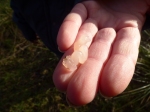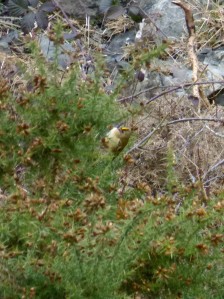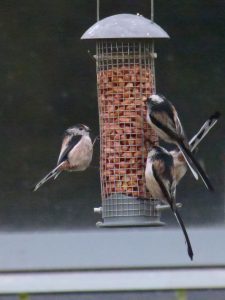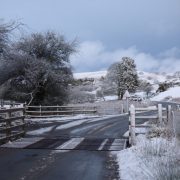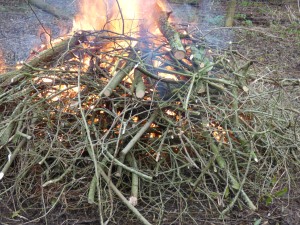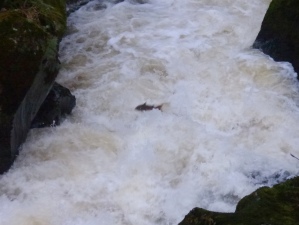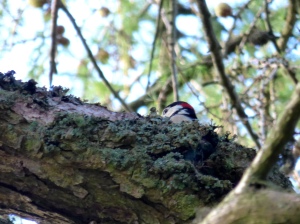Time enough for life, to unfold all the precious things
Before I crack on with my most recent wildlife adventures, I would like to quickly refer back to my blog post when I went to Stanner Rocks. First, to show two extra photos – taken by the local ecologist, Andy Shaw, I went to the reserve with. One shows myself, hunched over some plants to take photographs. The other shows a Peregrine Falcon, which had been at the reserve mere moments before I arrived (typical!).
Second, despite the praise that I heaped on Stanner Rocks, I managed to miss out some very vital information. Obviously, you’ve already read how it’s a nationally important site for plants. What I forgot to include there, is that it is the only UK site for a number of plants – the Radnor Lily (Gagea bohemica, pictured below beginning to bud) and the Perennial Knawel (Scleranthus perennis ssp perennis) for example. In addition, a number of other rare plants are there – Upright Clover (Trigolium strictum), Sticky Catchfly (Silene viscaria), Spiked Speedwell (Veronica spicata), Rock Stonecrop (Sedum fosterianum), Pale St John’s-wort (Hypericum montanum), Upright Chickweed (Moenchia erecta), and that’s without even mentioning the lower plants! There are rare mosses (apple moss sp, Bartramia stricta), liverworts (Black Crystalwort, Riccia nigrella) and lichens (Elm Sap-weep Lichen, Bacidia incompta) there too!
So if you end up in the area and fancy visiting somewhere amazing, Stanner Rocks is a good bet. But remember, my note from last time:
NOTE: Should you wish to visit Stanner Rocks, there is very limited access due to the sensitivity of the plants and that the landscape can be quite hazardous. Contact National Resources Wales should you wish to visit!
- At Stanner Rocks, photo by A.G.Shaw
- Peregrine at Stanner Rocks, photo by A.G.Shaw
- Radnor Lily beginning to bud
Now onto animals again. Finding myself unemployed when my contract at Radnorshire Wildlife Trust came to an end, I was feeling a little bit down. However, I realised that this is actually a blessing in disguise (as long as the unemployment doesn’t stretch for too long). First, being unemployed means job interviews, and being in the conservation sector, this means job interviews in fantastic locations – you’ve already seen my visits to Charmouth and Lulworth Cove, and later in this blog post you’ll see another brilliant location. Second, being unemployed gives me some time to focus on wildlife a bit more – whether it is reading some fantastic books, or discovering wildlife in my local park (see later in this post).
So the year has been passing us by, and as I write, we’re already nearing the end of February! I was beginning to get a little frustrated – I’d not yet caught any moths! But all this was to change upon my return to London. Feeling hopeful, but resigned to reality, I set out my trap in the suburban garden. Lo and behold, the next morning revealed two moths! A Satellite (Eupsilia transversa) and a Hebrew Character (Orthosia gothica), so as you can imagine I was utterly thrilled! Whilst I’ve not caught anything since, I am still riding on the joy that I’ve finally caught my first moths for 2015.
- Hebrew Character (Orthosia gothica)
- New gloves!
Being back in London doesn’t mean I’m only in London. Fortunately for me, my parents have a little flat down in Kent, and I wasn’t back from Wales long before we headed down there. An extra bonus is my parents’ ownership of a small motorboat, and soon we were out on the river. I even had a go at steering! But only when the river was straight and there were no other boats about – I’m not a confident person on boats.
Whilst this trip was lovely, I found myself getting very frustrated as there was litter everywhere! The storms / floods of 2013-14 had washed a lot of debris into the river, and it’s still there! Upon returning to the flat, I bought myself some marigolds (Fair Trade rubber!) with which to do litter picking – you may remember that picking up more litter is one of my 2015 wildlife resolutions. Another resolution is to see a kingfisher, and I was feeling hopeful on this trip as my parents often see one on the river. Alas, it was not to be.
- Full steam ahead!
- Beware Kent river users, Megan is on the loose!
- Litter
- Litter
During this week, I had the good fortune to be invited to WWT Slimbridge in Gloucestershire for a job interview. Whilst I didn’t get the job, it was a really fantastic day and I had the opportunity to play around with the settings of my camera (another wildlife resolution). I didn’t get any lifer bird ticks (i.e. birds I’ve not seen before), because apparently you can’t count the cranes / smews at Slimbridge for some reason. However, I did get a number of year ticks. In addition, I managed to see a male Reed Bunting in winter plumage – having only seen one in summer plumage previously. Well done to my dad for spotting it – I was busy attempting to get a half-decent photo of the Water Rail.
- Male Pintail (A.acuta)
- Crane (G.grus)
- Male Greenfinch (C.chloris)
- Water Rail (R.aquaticus)
- Male Reed Bunting (E.schoeniclus) in winter plumage
- Bewick’s Swan (C.columbianus)
- Black-headed Gull (C.ridibundus)
- Black-headed Gull (C.ridibundus)
- Female Smew (M.albellus)
Naturally, there weren’t just birds at WWT Slimbridge. I’ve not yet worked out what the fungus is, a task for me to undertake. I knew the flower straight away – Blackthorn (Prunus spinosa), which is another name for Sloe. The flower is very similar to that of Hawthorn (Crataegus monogyna), but the leaves of the two plants are different and the leaves of the Hawthorn come out before its flowers (vica versa for Blackthorn). I just had to include a photo of the otters at Slimbridge – they’re such beautiful creatures.
And on the way back from Slimbridge, I was invited to pop in and see Sally-Ann Spence, aka Minibeast Mayhem. I do believe that she is one of the loveliest and most inspirational people I have had the good fortune to meet, and I look forward to our future chats about bugs, the environment and life in general.
- Jelly Ear fungus (Auricularia auricula-judae)
- Blackthorn / Sloe flower (Prunus spinosa)
- North American River Otters
This brings me to my walk in the park. And what a walk it was! It was only going to be a standard lunchtime dog walk, and I took my camera along just in case – you never know what you might see after all! I made the decision to do a bit of digging around, and ending up stripping some bark from a fallen branch – resulting in lots of invertebrates (many are still being identified!). Not long after, I came across a good variety of fungi as well. What I found particularly interesting whilst there, is that nobody asked me what I was looking at! I wonder how many people walk past these fantastic species / habitats and don’t take a closer look at them?
- Crystal Brain fungus (Exidia nucleata)
- King Alfred’s cakes fungus (Daldinia concentrica)
- Beetle (Nalassus laevioctostriatus)
- Earwig (Forficula auricularia)
My dog was very patient with me, bless him. When he was younger, if we stood still for too long he would get bored and start barking at us. But this time, he just found himself a stick to chew on whilst I was busy looking at and photographing the wildlife. He can be quite helpful sometimes – you may remember that I found some Crystal Brain Fungus (Myxarium nucleatum) back in December at my local park, which was on a stick he wanted to play with.









































